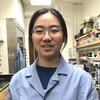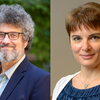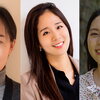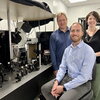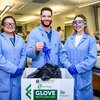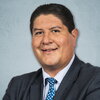Analytical Chemistry at Illinois is among the strongest programs in the country and has been so for over three-quarters of a century. This long, rich tradition is perpetually refreshed as faculty and students complete work in maturing areas and then open new vistas. Currently, there is great excitement in bioanalytical chemistry and non-biological surface catalysis. This impact focus contrasts with the stereotypical view that analytical chemistry is about instrument and method development. In fact, many novel instruments and techniques are developed in the course of research. There are so many instruments and techniques one might pursue that the wise selection of these developments is based on cutting-edge problems in biomedicine, catalysis, energy production and conservation, ecology, and other real-world problem areas. Among the developments at Illinois in recent years has been:
- Nano-resolved electroanalytical platform development for studying neurotransmission at single and bio-nanostructures
- Detection of peptides in single nerve cells by MALDI mass spectrometry
- NMR of nanoliter samples
- Fabrication of molecular gating devices for switching analytes as they transit nanofabricated microfluidic switchyards.
- Characterization of the fundamental corrosion processes active in aluminum and ferric alloys.
- Development of nanostructured catalysts for fuel cells giving world-record current densities and relative freedom from poisening.
- Large-scale sequencing of proteins starting with intact molecules with molecular weights over 50,000.
All this is accomplished in a friendly, collegial atmosphere where students may have multiple research advisors, and may collaborate with other students and faculty across campus, across the nation, and around the world. Because of the quality and size of support facilities, the question rarely is "do we have the ability to push back scientific frontiers" but rather is "with whom should we collaborate to most rapidly and easily push back the frontiers?" Facilities supporting the development and exploitation of modern measurement technologies include:
- School of Chemical Sciences machine, glass, and electronics shops.
- Mass spectrometers, both in School facilities and individual research groups.
- Magnetic resonance spectrometers in the VOICE NMR lab, Illinois EPR Research Center, and individual research groups.
- Surface science equipment at the Seitz Materials Research Center, individual research groups, and in the ACES and Veterinary Medicine colleges.
- Laser spectrometry equipment in research groups and central facilities allowing nearly any optical analytical technique to be carried out routinely.
- DNA sequencing, protein sequencing, and biomolecule synthesis through the Biotechnology Center and Institute for Genomic Biology.
- Collaboration with biologists, computer scientists, psychologists, and engineers through the Beckman Institute and the National Center for Supercomputing Applications.
- One of the largest, most complete library collections in North America. Illinois has the largest chemistry collection of ANY university in the world that has a graduate program in Analytical Chemistry
Please browse through our research descriptions and feel free to contact any of us to discuss our research interests, programs, and interdisciplinary activities. You'll find that Illinois has a unique blend of scholarly excellence and friendly, collaborative atmosphere.
Related News
- Scientists are exploring many ways to use light rather than heat to drive chemical reactions more efficiently, which could significantly reduce waste, energy consumption, and reliance on...
- Photosynthesis, or the ability of plants, algae and some bacteria, to convert light energy into chemical energy is inspiring one research team at the Beckman Institute for Advanced Science and...
- Three faculty members in the Department of Chemistry have received promotions. Josh Vura-Weis has been promoted to full professor by the University of Illinois at Urbana-Champaign. And Hee-Sun Han...
- This past academic year, undergraduate student researcher Santiago Castro had a lot to learn when he joined the organic chemistry lab of Prof. Jeff Chan. Despite his lack of experience in an organic...
- A third-year graduate student, Dong Ok Kim has been a mentor for the past two years to Michelle Zorigt and Martha Kubakh, two undergraduate researchers in the electrochemistry lab of professor...
- Feature story about chemistry professor Joaquín Rodríguez-López appeared in the Spring 2025 edition of the College of LAS alumni magazine, ...
- Chemistry Professor Stephan Link is one of three faculty members at the University of Illinois Urbana-Champaign who have been named 2024 Fellows of the American...
- Hee-Sun Han, assistant professor of chemistry and Cancer Center at Illinois (CCIL) member and assistant professor of chemistry has...
- The Electrochemical Society awarded the 2024 Electrodeposition Division Research Award to Professor Andrew A. Gewirth...
- A tiny, four-fingered “hand” folded from a single piece of DNA can pick up the virus that causes COVID-19 for highly sensitive rapid detection and can even block viral particles from entering cells...
- The National Institute on Drug Abuse (NIDA) has awarded a $5.6 million grant to the Neuroproteomics & Neurometabolomics Center on...
- Today the U.S. Department of Energy (DOE) announced the creation of two new Energy Innovation Hubs. One of the national hubs, the Energy Storage Research...
- A newly funded U.S. National Science Foundation iBioFoundry at the University of Illinois Urbana-Champaign will build on more than a decade of research at the U. of I. to integrate synthetic biology...
- The Department of Chemistry is welcoming three new tenure-track faculty members this academic year. Joomyung “Vicky” Jun joined the department as an assistant professor in August, and Xiaotang Lu...
- Joaquín Rodríguez-López has been named a University Scholar in recognition of excellence in teaching, scholarship and service. Rodríguez-López, is one of five University of Illinois professors at...
- Using nano-sized gold particles that are great light absorbers, researchers at the University of Illinois Urbana-Champaign and their collaborators have discovered a faster way to transfer and boost...
- The two chemistry emeritus professors were among a trio of University of Illinois Urbana-Champaign faculty members elected to the National Academy of Sciences, one of the highest honors a...
- Through the Kimberly-Clark Right Cycle Program, teaching labs and some research labs in the Department of Chemistry diverted 1.03 tons or 2,278 pounds of PPE waste in 2023, earning the department a...
- The AAAS selected Prof. Landes “for the development of next-generation tools and models to image and understand dynamics governing separations at soft interfaces at the single analyte limit.”
Related Content
- Jason Wu is a graduate student from Newton, MA, pursuing his doctorate in the research groups of chemistry Prof. Nick Jackson and chemical and biomolecular engineering Prof. Charles Schroeder....
- Originally from Central Mexico, Professor Joaquín Rodríguez-López grew up in Monterrey, the third-largest city in Mexico, famous for its industrial centers and mountains. He attended Tecnológico de...



